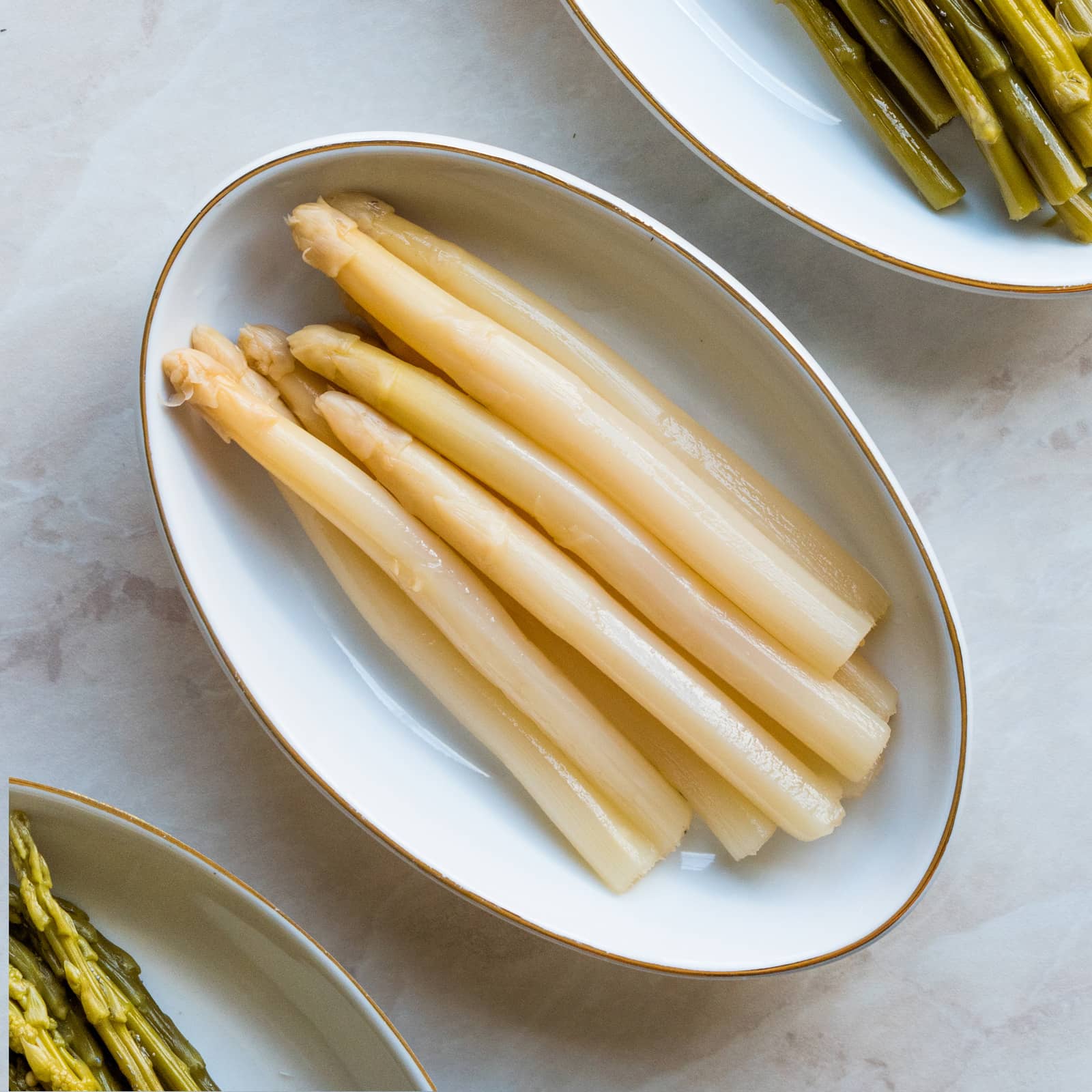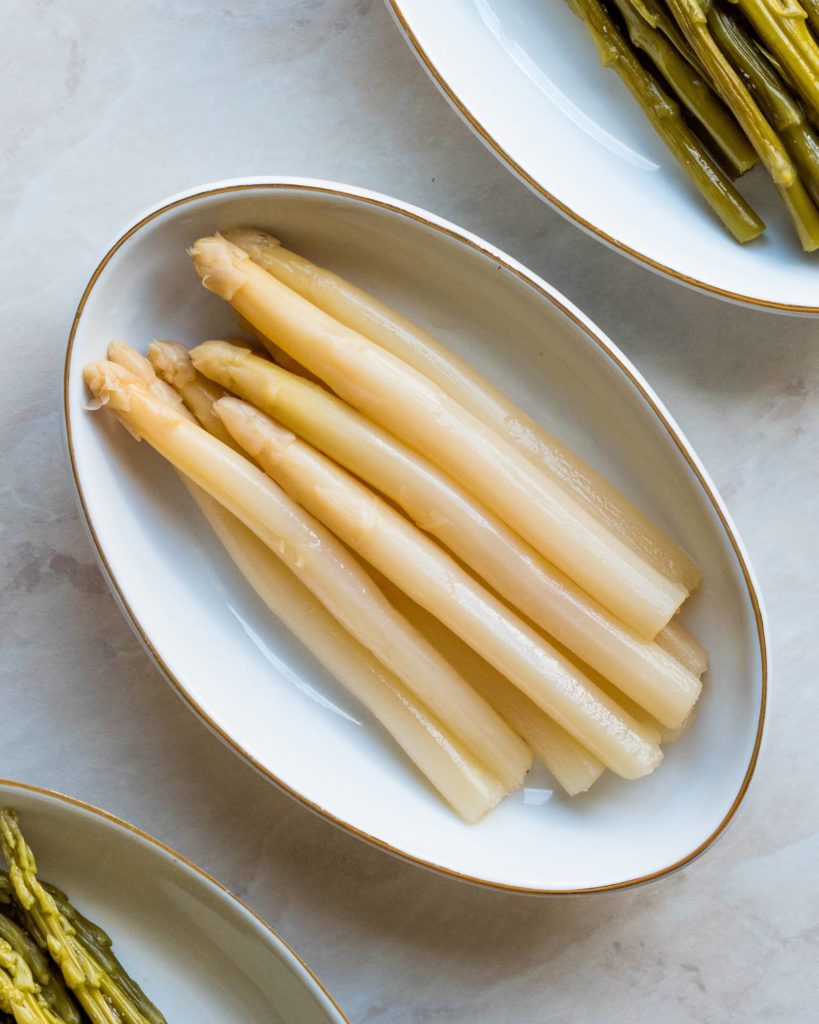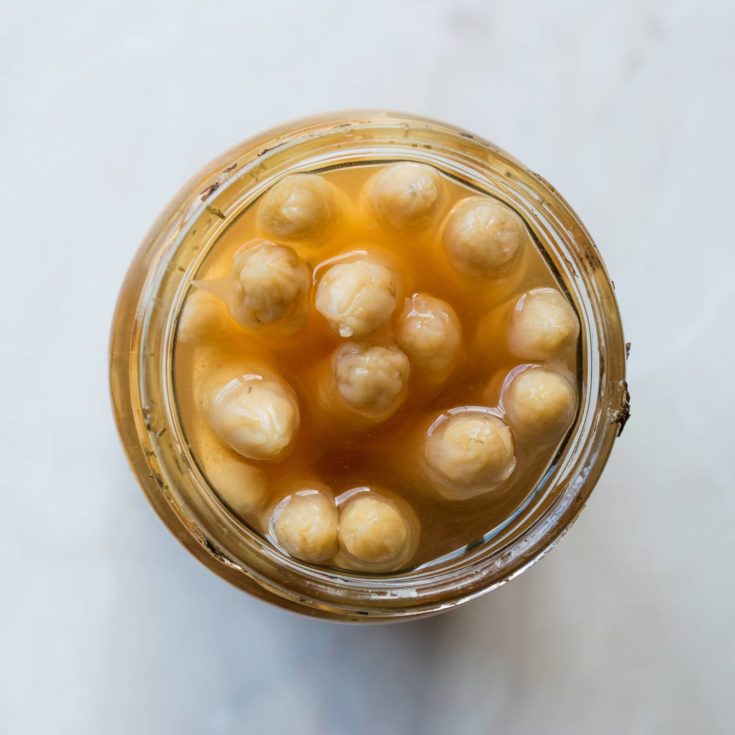Kiszone Szparagi po Pakosławsku
Lacto-fermented Asparagus
How to pronounce it?
kee-shoneh shpara-ghee
‘Play’ to hear:

Fermented asparagus is a very different story from the sautéed, steamed, roasted or pickled spears that we all know and love.
When fermented, it’s delightfully crunchy, with a fresh, slightly sour taste and a distinct aroma, that cannot compare to anything else.
If you’ve never fermented asparagus before, this regional Polish recipe is a good place to start. It’s a clever way to extend the short asparagus season and capture the taste of spring in a jar.
For the full list of ingredients & detailed instructions, please see the recipe card at the end of this post. But before you scroll, there’s important stuff to know below.
Wielkopolska (Greater Poland) is renowned for its excellent asparagus. Its cultivation in this region dates back to the 19th century. During the Prussian partition, German settlers established their farms here and brought white, green and purple stalks along with them. (source in Polish)
With time, Polish farmers took over these crops, continuing their production. To extend the scandalously short asparagus season, they started fermenting them – the same way as other fruit and veggies, most notably, cucumbers.
In the village of Pakosław (southern Wielkopolska), the traditional fermentation process involves a salty brine with the addition of oak leaves, horseradish root, garlic and fresh dill. Once soured, asparagus keeps its wonderful colour, crispness and firmness.
If you would like to visit the village and taste the ‘real deal’, visit Wojciechówka farm, renowned for its fermented asparagus. (website in Polish, right-click in Chrome browser and select “translate to English”).
In 2010, fermented asparagus from Pakosław was officially listed on the “Traditional Products” list of the Ministry of Agriculture under the name of “Szparag kiszony pakosławski”. (entry in Polish)
Do you need any special ingredients or equipment?
No, not really.
In Poland, asparagus season starts in mid-April and lasts for around 2 months. Any colour is fine – may it be white, green or purple.
When shopping for the freshest asparagus, keep an eye out for a firm stalk and a closed, tight tip. Avoid limpy, wrinkly spears, as they’re likely to be old and unpleasantly fibrous.
You’ll find that the recipe calls for blackcurrant and oak leaves. They contain tannins, which keep the stalks firm and crunchy during the fermentation process. If you can’t find them, just skip them.
Equipment-wise, you’ll need:
- 32 oz (roughly 1 litre) jar with a lid, or larger
- something that can serve as a weight, to prevent the asparagus from floating: may it be fermentation weights, ceramic pie weights, a simple plate or even… rocks (just boil them for 20 minutes before use, to get rid of any unwanted bacteria).
What to serve it with?
Fermented asparagus is delicious on its own, enjoyed straight off the jar.
But you could also serve it as:
- side for roasts, meat and fish dishes
- ‘zakąska’ (drinking snack/finger food) on a cheese board or charcuterie board
- sandwich topping
You could also toss it into a salad, or chop it finely to use in krokiety or pierogi fillings.
Can you make it another way?
Yes. That’s what’s awesome about fermented foods – you can play around with the ingredients. Here are some ideas:
- peppercorns: black, pink, white
- lemon, lime, orange slices
- ginger root, chili peppers
- allspice berries, bay leaves, cloves, coriander seeds
- dried fruit, e.g. cranberries, prunes, raisins
- berries and currants
- fresh herbs of your choice
What diets is it suitable for?
Fermented asparagus is vegan, dairy-free and gluten-free. It is also suitable for those who follow keto and low-carb diets.
How long can you keep it in the fridge?
Once the jar ends up in the fridge, you can enjoy it for 6 months, or even longer. But in general, it disappears pretty quickly, you’ll definitely finish the jar before it goes off.
Can I freeze it?
No, it’s not worth it. Once frozen, fermented asparagus looses its crunch and turns rubbery. Plus, you would loose most of its healthy probiotics.

Recipe: step by step
Lacto-fermented Asparagus (from Greater Poland region)

For accuracy, use a digital scale and measure in the metric system (litres and grams). Imperial units are just a guideline here.
Ingredients
For the brine (3.5%)
- 2 tablespoons (35 g) salt; non-iodised
- 4 cups + 4 tablespoons (1 litre) water
Asparagus and Aromatics
- 2 bunches asparagus; white, green or purple (2 lb; ~ 900-1000 g, or more if it fits in your jar)
- 4-5 garlic cloves; peeled
- 1 teaspoon white mustard seeds
- 0.7 oz (20 g) horseradish root, roughly the size of two thumbs; cut into strips
- 5-6 oak leaves, optional
- 5-6 blackcurrant or cherry leaves, optional
- 4-5 sprigs fresh dill
Instructions
- Add salt to boiling water, stir to dissolve. Set aside to cool.
- Peel asparagus just below tips, cut off woody ends. If your jar is short and wide, cut asparagus stalks in half.
- Place garlic cloves and mustard seeds at the bottom of the jar. Place asparagus upright, alongside horseradish (cut into strips), oak and blackcurrant leaves, and sprigs of fresh dill.
- Pour in the brine. Everything has to be is fully submerged, it cannot stick above the liquid. Weigh asparagus down, to prevent it from floating. Use fermentation weights, ceramic pie weights, a simple plate or even… rocks (boil them for 20 minutes before use).
- Cover with a lid and let asparagus ferment:
- Initially, leave the jar in a warmer spot (e.g. kitchen) for 5-6 days. Open the jar daily to release the gases.
- Next, move it into a cooler place, such as a pantry or a cellar (54-64°F, 12-18°C) for a further 6 weeks.
- After that time, store them in the fridge. Enjoy for the next 6 months (or even longer).
Notes
- Some recipes online indicate a much shorter fermentation time, recommending as little as 5 days. But having tried them after just under a week, I found them inedible. The flavour has improved greatly with time. The sweet spot seems to be: 5-6 days in warmth, 6 weeks in a cooler spot and 1+plus weeks in the fridge.
- Please note: Lacto-fermentation is a natural process, and the outcome can be unpredictable.
Nutrition Information:
Yield:
6Serving Size:
1Amount Per Serving: Calories: 78Total Fat: 1gSaturated Fat: 0gTrans Fat: 0gUnsaturated Fat: 0gCholesterol: 0mgSodium: 4mgCarbohydrates: 19gFiber: 0gSugar: 0gProtein: 2g
Polonist is reader-supported. When you buy through links on our site, we may earn a small affiliate commission. Learn more
Recipe Information
Filed under:
Alternative traditional/regional names:
Also known / Misspelt internationally as:
Tested by:
First published on:
Recipe by / Adapted from:
Story by:
Bibliography / References: